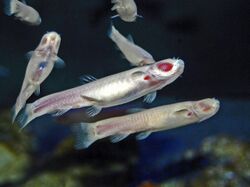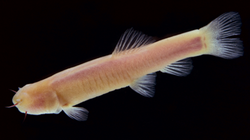Biology:Phreatichthys andruzzii
| Phreatichthys andruzzii | |
|---|---|

| |

| |
| Scientific classification | |
| Domain: | Eukaryota |
| Kingdom: | Animalia |
| Phylum: | Chordata |
| Class: | Actinopterygii |
| Order: | Cypriniformes |
| Family: | Cyprinidae |
| Genus: | Phreatichthys Vinciguerra, 1924 |
| Species: | P. andruzzii
|
| Binomial name | |
| Phreatichthys andruzzii Vinciguerra, 1924
| |
Phreatichthys andruzzii, a species of cyprinid fish, is the only species of the genus Phreatichthys, and is endemic to Somalia.[1] This cave-adapted fish is whitish (not pigmented) and blind. It has no scales.[2] It is considered to have evolved in the cave environment for some two million years.[3] Its name derives from the Greek words phreasatos for spring, and ichthys for fish. It grows to a maximum length of 6.2 cm (2.4 in).[4]
This fish is the first animal discovered that does not adjust its biological clock with the light of the sun. It has an unusual internal clock, which measures the passage of time with an extremely long period (up to 47 hours). It is also completely blind to all light stimuli.[5][6]
Two other cavefish species are found in Somalia: the cyprinid Barbopsis devecchi and the catfish Uegitglanis zammaranoi.[7]
References
- ↑ 1.0 1.1 Getahun, A. (2010). "Phreatichthys andruzzii". IUCN Red List of Threatened Species 2010: e.T40703A10352666. doi:10.2305/IUCN.UK.2010-3.RLTS.T40703A10352666.en. https://www.iucnredlist.org/species/40703/10352666. Retrieved 15 November 2021.
- ↑ Battison, Leila (10 September 2011). "Fish living in dark caves still feel the rhythm of life". https://www.bbc.com/news/science-environment-14844053.
- ↑ Gough, Zoe. "Blind cavefish are able to 'count'". BBC. https://www.bbc.co.uk/nature/27663537. Retrieved 6 June 2014.
- ↑ Froese, Rainer and Pauly, Daniel, eds. (2011). "Phreatichthys andruzzii" in FishBase. August 2011 version.
- ↑ University of Ferrara. "Orologi biologici in un pesce cieco". Le Scienze Web. Archived from the original on 20 October 2011. https://web.archive.org/web/20111020012329/http://lswn.it/comunicati/stampa/2011/orologi_biologici_in_un_pesce_cieco. Retrieved 8 September 2011.
- ↑ Cavallari, N., Frigato, E., Vallone, D., Fröhlich, N., Lopez-Olmeda, J. F., Foà, A., Berti R., Sánchez-Vázquez, F.J., Bertolucci, C., Foulkes, N. S. (2011). A Blind Circadian Clock in Cavefish Reveals that Opsins Mediate Peripheral Clock Photoreception. PLoS Biology, 9(9), e1001142. http://doi.org/10.1371/journal.pbio.1001142
- ↑ Romero, A., editor (2001). The Biology of Hypogean Fishes. Developments in Environmental Biology of Fishes. ISBN:978-1402000768
Wikidata ☰ Q136470 entry
 |


